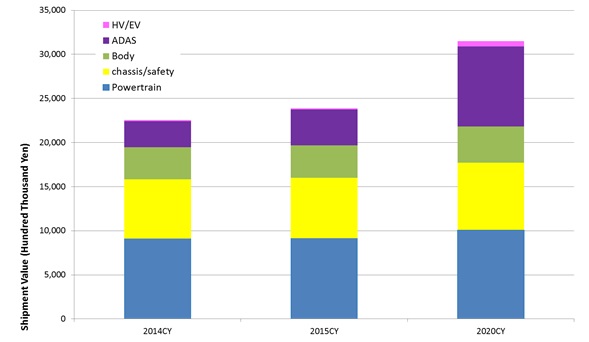Global In-Vehicle Sensor Market: Key Research Findings 2015
Research Outline
- Research period: From April to July, 2015
- Research targets: Manufacturers of car electronics, semiconductors, and electronic parts
- Research methodologies: face-to-face interviews by the expert researchers, survey via telephone/email, and literature research
<What are in-vehicle or in-car sensors?>
In-vehicle or in-car sensors are devices that detect necessary information (rotation, angle, pressure, impact, speed, and object) to control various systems within a vehicle. This research categorizes sensors by control system where the sensors are embedded: Powertrains to control an engine, chassis/passive safety for electrically-assisted power steering and brakes, body for head lights and air conditioning, ADAS (Advanced Driving Assistant System), and HV (Hybrid Vehicle)/EV (Electric Vehicle).
There are different types of sensor devices such as magnetic sensors and MEMS (Micro Electro Mechanical Systems) sensors. This research only targets those devices embedded in passenger cars and commercial vehicles that weigh 3.5 tons or less.
Summary of Research Findings
- Global Market Size of In-Vehicle Sensors in 2014 Rose by 26.8% from Previous Year to Attain 2,254.3 Billion Yen
Steady growth of the sensors for power trains and for ADAS has driven the global in-vehicle sensor market to increase by 26.8% from the preceding year, reaching 2,254.3 billion yen, based on the shipment value at manufacturers. The largest market share by demand is achieved by the sensors for powertrains occupying 40.5%, attaining 912.9 billion yen, followed by those for chassis/safety, 29.8% to achieve 671.4 billion yen, the third place comes the sensors for body, 16.1% to reach 362.5 billion yen, followed by those for ADAS, 13.2% to attain 297.3 billion yen, and lastly those for HV/EV, 0.5% to mark 10.2 billion yen.
- Forecast of Global Market of In-Vehicle Sensors in 2020 Reaches 3,148.7 Billion Yen, Boosted by Environmental Regulation, Improvement of Fuel Efficiency, and Increase of ADAS
In order to observe the environmental regulations and to improve fuel efficiency, more downsizing engines are likely to be adopted, and more transmission needed to be multi-staged, which, in turn, helps expand demands of the sensors for powertrains. In addition, with ADAS expected to spread further, CAGR (compound annual growth rate) of the global in-vehicle sensor market from 2014 to 2020 is likely to attain 5.7% and the market size for 2020 to achieve 3,148.7 billion yen, based on the shipment value at manufacturers.
- Sensors for ADAS Attains largest Growth Rate Among Entire In-Vehicle Sensors, Attaining 909.4 Billion yen for FY2020 and CAGR from 2014 to 2020 to be 20.5%
In the future, multiple in-vehicle sensors are likely to be introduced to form so called sensor fusion, aiming to enhance detection ability of ADAS and to enable multi-functions. This may bring about more sensors for ADAS to be embedded into a single automobile, expanding the opportunities of sensors to detect not only in the front but also to the side and the rear of the vehicle. Therefore, the global market of sensors for ADAS is expected to attain 909.4 billion yen by 2020 (based on the shipment value at manufacturers), with CAGR from 2012 to 2020 to achieve 20.5%.
- Figure 1: Transition and Forecast on Size of Global In-Vehicle Sensor Market
